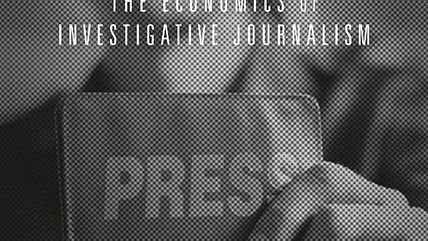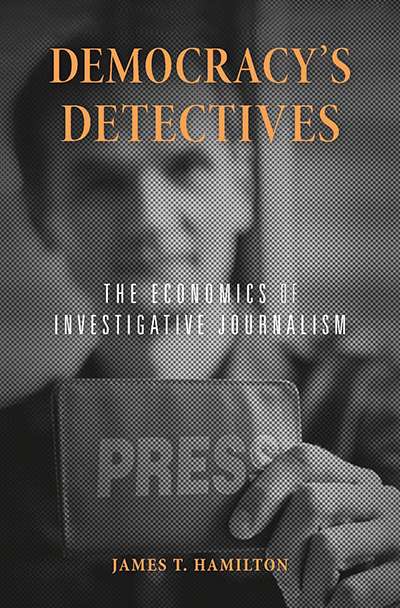Where Did All the Investigative Journalism Go?
The economics of the exposé

Democracy's Detectives: The Economics of Investigative Reporting, by James T. Hamilton, Harvard University Press, 368 pages, $35

Sloshed on 30 percent profit margins, the news media went on a drunkard's tear over the final three decades of the 20th century. Some publishers, such as Gannett, spent their loot acquiring more newspapers. The Boston Globe blew a portion of its windfall on foreign bureaus, establishing its first in the early 1970s and eventually expanding to five. Newspapers everywhere expanded regional and national bureaus, sprouted additional sections, added color printing, hired more journalists, and boosted circulation as the money bender continued.
Almost every news outlet—print or broadcast—spent heavily on investigative journalism, producing a scoop renaissance. The Johnny Deadlines dug deep to bust crooked cops, call out polluting corporations, and expose criminal justice outrages. Health care fraud, banking hijinks, payoffs, bribes, and government waste got a full press airing.
But the renaissance stalled at the new century mark as cable TV and the web encroached on the advertising monopoly the press had grown sozzled on. Then came the 2008–09 recession, reversing the grand expansion. The Globe closed all of its foreign bureaus; newspapers shed their suburban and regional bureaus; whole newspaper sections folded; and tens of thousands of journalists got sacked.
The investigative beat took a hit too, as James T. Hamilton, a Stanford professor of communications, explains in his comprehensive study, Democracy's Detectives: The Economics of Investigative Reporting. Unmistakable proof of the decline: No trade honors itself as grandly as journalism, so submissions to investigative award programs are a fine marker of how much of that genre is being produced. During the 2008–09 recession, submissions to the popular Investigative Reporters and Editors contest dropped 34.1 percent compared to 2006–07, indicating the extent of the cutback.
The biggest losers haven't been journalists—who cares about them, anyway?—but members of the public, from whom more perfidy is concealed, while public officials, bureaucrats, and corrupt businessmen have scored. "Which stories get discovered where depends on economics," Hamilton writes. By bringing the economist's eye to the business of investigative journalism, Hamilton sharpens our appreciation of the craft as he explores its history, the motivations publishers have to fund the work, and the cash benefits investigations pay out.
Investigative journalism, Hamilton tells us, produces extraordinary benefits—perhaps billions of dollars' worth. A journalistic investigation of government waste can save taxpayers a lot of dough if officials pay attention. A successful probe of commercial fraud can likewise prevent crooks from looting millions from consumers and investors. And where a dollar figure can be placed on health, the best investigations can save untold millions when policies change.
The tragedy of investigative journalism is that its publishers can never come close to fully monetizing those benefits. Investigative journalism, in the economist's parlance, produces positive externalities by the tanker-load which almost everybody except news outlets ends up reaping. If it were feasible for an outlet to claim even a tiny vig from the benefits they produce, we'd likely see tons more investigations.
Instead, investigative journalists and their publishers must depend on indirect payouts. Reporters can reap psychic income for their work, for example, and the proliferation of investigative journalism prizes show that they're cleaning up in that market. Some publications back investigative projects for partisan reasons. Others depend on them as part of the bundle that attracts paying customers and advertisers. Still others publish investigations out of a desire to change or improve the world.
Because the number of readers willing to help underwrite ambitious investigations is always relatively few, and because news outlets can never capture the benefits generated by their work, many projects depend on a pattern of direct subsidies—the NPR, ProPublica, and Mother Jones nonprofit model. The commercial press generally pumps indirect subsidies from the profitable sides of the business, entertainment and service journalism and advertising, to this money-losing side. As newspaper profits have eroded, as Hamilton and everybody else has noted, this subsidy has receded, diminishing accountability journalism in many places.
What is to be done? Must every investigative outlet rely on patrons like Joan Kroc, whose estate gave $200 million to NPR, or Herbert and Marion Sandler, who staked ProPublica, or eBay billionaire Pierre Omidyar, who started The Intercept, or other foundation support?
Perhaps the salvation of investigative reporting lies not with finding additional filthy rich contributors or the return of 30 percent margins. Hamilton's book explicitly states that one reason for the high costs of investigations is the government's resistance to making information easily accessible. Every journalist who has filed a Freedom of Information Act (FOIA) request for documents or data has a favorite story about the months or years it takes the authorities to comply. Many of these stories have a coda: Often the most pertinent information has been redacted or gone missing in the archives.
Such foot-dragging and obfuscation cost journalists time, and time is money. (Side thought, via novelist Martin Amis: "If time is money, fast food saves both.") Hamilton echoes journalists by calling for stronger FOIA laws to speed the release of information, for hosting FOIA releases in computer-retrievable portals, and for lowering the fees some agencies demand for their searches and releases. If investigative reporting were easier and cheaper to do, we'd get a lot more of it, and the sort of people targeted by investigations might be deterred from breaking the law if they knew they were being watched.
But most policy makers have little interest in improving the investigative environment. As Michael Schudson points out in his recent book The Rise of the Right to Know, the federal FOIA owes its origins less to an impulse to assist journalists than to Congress' desire to rein in the imperial presidency. FOIA applies only to the executive branch, not to the courts or Congress itself. In other words, it was first and foremost an injury one branch of government inflicted on another, not a good-government attempt at transparency.
Rather than waiting for more journalism philanthropy, tougher FOIA, and greater data transparency—laudable as they all may be—we might be better served in the short term by first asking why we need investigative journalism in the first place. The chart of the most popular topics among investigative and reporter contest entries indicates that some form of government malfeasance or dereliction attracts the majority of meaningful investigation. In other words, government is the great fertilizer of the investigative pasture. Its contracting frauds, the police abuses it perpetuates, and its endless futzing with schools, transportation, the military, the prisons, and everything else in its portfolio suggest that investigative journalist may have their priorities wrong. Instead of attacking the branches of government corruption, perhaps reporters and editors should ask if the most tainted part of the tree isn't really the trunk.
This is not to suggest that reducing the reach and scope of government alone would make investigative journalism obsolete. Thieves and miscreants infest the private sector too, so policing government better or making it smaller and more accountable won't eliminate the need for investigations. Man's heart is a big slab of dark meat, after all. But any serious effort to rescue investigative journalism from its current decline should be preceded by a meta-investigation of the basic reasons we need the form in the first place.
This article originally appeared in print under the headline "Where Did All the Investigative Journalism Go?."



Show Comments (22)